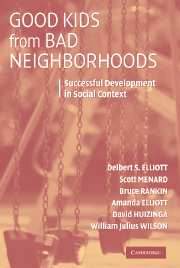Book contents
- Frontmatter
- Contents
- List of Tables and Figures
- Foreword by Richard Jessor
- Acknowledgments
- 1 Growing Up in Disadvantaged Neighborhoods
- 2 Growing Up in Denver and Chicago: The MacArthur Neighborhood Study
- 3 Good and Bad Neighborhoods for Raising Children
- 4 The Effects of Growing Up in a Bad Neighborhood: Initial Findings
- 5 Critical Dimensions of Neighborhood Organization and Culture
- 6 The Effects of Neighborhood Organization and Culture
- 7 Family Influences: Managing Disadvantage and Promoting Success
- 8 School Climate and Types of Peer Groups
- 9 What Matters Most for Successful Youth Development?
- 10 Successful Development in Disadvantaged Neighborhoods
- Appendix A
- Appendix B
- References
- Author Index
- Subject Index
6 - The Effects of Neighborhood Organization and Culture
Published online by Cambridge University Press: 06 August 2009
- Frontmatter
- Contents
- List of Tables and Figures
- Foreword by Richard Jessor
- Acknowledgments
- 1 Growing Up in Disadvantaged Neighborhoods
- 2 Growing Up in Denver and Chicago: The MacArthur Neighborhood Study
- 3 Good and Bad Neighborhoods for Raising Children
- 4 The Effects of Growing Up in a Bad Neighborhood: Initial Findings
- 5 Critical Dimensions of Neighborhood Organization and Culture
- 6 The Effects of Neighborhood Organization and Culture
- 7 Family Influences: Managing Disadvantage and Promoting Success
- 8 School Climate and Types of Peer Groups
- 9 What Matters Most for Successful Youth Development?
- 10 Successful Development in Disadvantaged Neighborhoods
- Appendix A
- Appendix B
- References
- Author Index
- Subject Index
Summary
SYNOPSIS
In the last chapter, we argued that socioeconomic disadvantage and physical deterioration influence youth development primarily through the patterns of social interaction among residents in the neighborhood. Over time, this interaction gives rise to a particular type of social organization and culture. A neighborhood with a strong institutional presence, informal networks of residents that promote a positive development and discourage dysfunctional behavior, consensus on neighborhood norms and values, and the ability to resist the introduction of drugs, crime and other negative influences in the neighborhood, is organized to promote a positive course of youth development. This type of organization/culture can protect youth from the potential negative effects of disadvantage and deterioration. Typically, however, disadvantaged neighborhoods have a weak and ineffective organization and unsupportive culture, as these demographic conditions tend to undermine and restrict social interaction between residents. The evidence for this set of relationships is presented in this chapter.
Measures of the organizational and cultural features of a neighborhood that provide a positive, supportive environment for youth development are described and include: Institutional Effectiveness, Informal Networks, Neighborhood Bonding and Control, Normative and Value Consensus, (limited) Illegal Modeling, and (limited) Illegal Performance Opportunities. A composite measure, General Organization, comprised of all six individual scales is also described. A neighborhood organizational typology is also developed using the six organization/culture measures, classifying neighborhoods as Organized, Regular, Weak, and Disorganized.
As expected, neighborhoods that are Disadvantaged and Deteriorated tend to be poorly organized and have unsupportive, sometimes nonconventional or deviant cultures.
- Type
- Chapter
- Information
- Good Kids from Bad NeighborhoodsSuccessful Development in Social Context, pp. 129 - 160Publisher: Cambridge University PressPrint publication year: 2006

